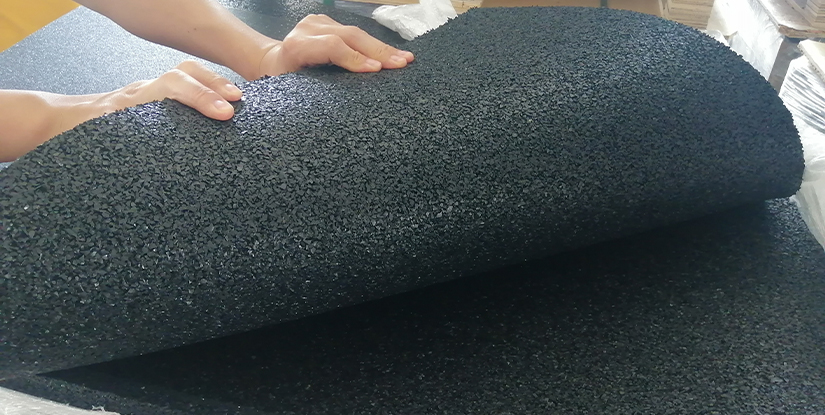Treadmill Noise Reduction Mat: Buyer's Guide & Benefits

Overview
A treadmill noise reduction mat is a purpose-engineered solution used to reduce vibration, dampen sound, and protect flooring underneath cardio equipment. For commercial gyms, home fitness rooms, and apartment dwellers, selecting the right mat balances acoustic performance, durability, and ease of installation. This article covers materials, performance metrics, selection criteria, installation best practices, maintenance, and common compatibility considerations.
Why a Noise Reduction Mat Matters
Running on a treadmill generates both impact vibration and airborne noise. Without mitigation, these forces can transmit through subfloors and structural elements, causing neighbor complaints, premature equipment wear, and aesthetic damage to finishes. A quality mat addresses three objectives:
- Vibration isolation — reducing energy transfer to the floor structure.
- Sound attenuation — absorbing and dissipating airborne and structure-borne noise.
- Surface protection — preventing scratches, indentations, and sweat damage to subflooring.
Materials and Construction
Mats are manufactured from several materials, each offering distinct properties:
- Recycled rubber: Dense, long-lasting, and effective for both vibration and impact noise. Often used in commercial settings.
- High-density foam: Lightweight and affordable, suitable for light to moderate use but less durable under heavy loads.
- Composite layered mats: Combine rubber with a closed-cell foam or polymer layer to balance shock absorption and surface grip.
Key construction attributes to evaluate include thickness, material density (durometer), edge beveling to reduce trip hazards, and anti-slip backing or textured top surfaces.
Performance Metrics to Consider
When evaluating mats, reference objective measures where available:
- Decibel reduction (dB): Indicates airborne noise attenuation; expect modest reductions (typically 3–10 dB) depending on mat quality and installation.
- Vibration isolation rating: Look for technical data or lab test results showing transmissibility at relevant frequencies (20–200 Hz for treadmill impacts).
- Load-bearing capacity: Ensure the mat maintains integrity under the dynamic weight and high contact pressure of treadmill feet and motors.
Sizing and Compatibility
Choose a mat that fully supports the treadmill footprint with an additional margin of 4–12 inches on all sides to catch sweat and reduce edge lift. For multi-unit installations or platforms, consider modular interlocking tiles that distribute loads and simplify servicing. Verify that the mat does not obstruct any ventilation or leveling feet and that it remains stable beneath incline mechanisms or cargo weight.
Installation Best Practices
- Clean the subfloor to remove dust and debris before laying the mat.
- Allow the mat to acclimate to room temperature if it was stored in a significantly different environment—this reduces curling.
- Place the treadmill on the mat, then engage leveling feet and position stabilizers per the manufacturer’s instructions.
- If necessary, use mechanical fasteners only at the perimeter on platforms where adhesives are not permitted by building codes.
Maintenance and Longevity
Routine care preserves acoustic performance and appearance:
- Wipe down after workouts to remove sweat; avoid solvents that can degrade rubber or foam.
- Inspect edges and seams regularly; trim curled edges or replace sections that show cracking.
- Rotate or reposition modular tiles periodically in high-wear areas to extend life.
Buying Considerations
When selecting a mat, prioritize the following:
- Proven material density and laboratory or field test data if available.
- Warranty terms that cover compression set and degradation under treadmill loads.
- Compatibility with your treadmill model and any manufacturer recommendations — some treadmill warranties require specific flooring conditions.
Environmental and Safety Notes
Choose materials with low volatile organic compound (VOC) emissions to protect indoor air quality. Recycled rubber products offer sustainability benefits but verify that binders and additives meet local indoor air standards. Ensure the mat has beveled edges or ramps in high-traffic areas to minimize trip risk.
Conclusion
A well-selected treadmill noise reduction mat delivers measurable reductions in vibration and noise, protects flooring investments, and enhances workout stability. Focus on material density, thickness, proven performance metrics, and correct sizing to maximize benefits. Proper installation and maintenance will extend service life and maintain acoustic performance.
FAQs
1. Will a mat eliminate treadmill noise completely?
No. Mats reduce vibration and airborne noise but do not eliminate all sound. Expect meaningful reductions, not silence.
2. What thickness is best for treadmills?
3/8-inch to 1/2-inch (10–12 mm) is typical for home use; heavier commercial units may require thicker, denser rubber.
3. Can a mat void my treadmill warranty?
Rarely. Check your treadmill’s warranty terms; most manufacturers permit mats but may restrict certain adhesives.
4. Are recycled rubber mats safe indoors?
Yes, if they meet VOC and emission standards. Choose certified low-VOC products when indoor air quality is a priority.
5. How do I clean a treadmill mat?
Wipe with a damp cloth and mild detergent. Avoid strong solvents that can damage rubber or foam.
6. Can mats protect against floor indentations?
Yes. Dense mats distribute load and reduce point pressure from treadmill feet, minimizing permanent floor indentations.
7. Is heavier always better?
Not always. Density and material quality matter more than weight alone. Heavy but low-density foam may compress quickly.
8. Do interlocking tiles perform as well as a single mat?
High-quality interlocking tiles can perform comparably while offering ease of replacement and customization for large spaces.
9. Where should I place the mat in a multi-unit building?
Place it directly beneath the treadmill with at least 4–12 inches of overlap on all sides; avoid placing across seams in raised subfloors when possible.

